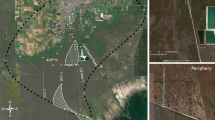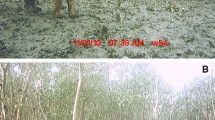Abstract
In migration analysis of the brown planthopper, Nilaparvata lugens (Stål), in a tropical region, it is difficult to know the arrival timing of the immigrants because rice plants in different growth stages are simultaneously cultivated, and local insects may already occur in destination areas. Due to this analytical difficulty, additional information is necessary to discriminate between immigrants and locally originated individuals in the light trap catch. This study applied rice phenology maps retrieved from satellite images to analysis of N. lugens’s migration in the Vietnamese Mekong Delta. The analysis also employed occurrence data by dense light traps and trajectory analysis. The result showed that the occurrence of N. lugens peaked periodically at an interval of 27.2–30 days, changing in association with the rice cropping area in the harvesting stage. For an N. lugens occurrence in late July 2009 in the delta, the rice phenology suggested catch increases in light traps in a destination area could likely be attributed to immigrants from outside the area. Therefore, the migration analysis suggested that N. lugens that emigrated from paddy fields in An Giang and Kien Giang provinces possibly moved to east-neighboring provinces. The migration distance was estimated to be about 100 km at a maximum.





Similar content being viewed by others
References
Cabauatan PQ, Cabunagan RC, Choi IR (2009) Rice viruses transmitted by the brown planthopper Nilaparvata lugens Stål. In: Heong KL, Hardy B (eds) Planthoppers: new threats to the sustainability of intensive rice production systems in Asia. International Rice Research Institute, Los Banos, pp 357–368
Cheng SN, Chen JC, Si H, Yan LM, Chu TL, Wu CT, Chien JK, Yan CS (1979) Studies on the migrations of brown planthopper Nilaparvata lugens Stål. Acta Entomol Sin 22:1–21
Cook AG, Perfect TJ (1985) The influence of immigration on population development of Nilaparvata lugens and Sogatella furcifera and its interaction with immigration by predators. Crop Prot 4:423–433
Cook AG, Perfect TJ (1989) The population characteristics of the brown planthopper, Nilaparvata lugens, in the Philippines. Ecol Entomol 14:1–9
Draxler RR (1999) HYSPLIT4 user’s guide. NOAA Tech. Memo. ERL ARL-230, NOAA Air Resources Laboratory, Silver Spring, MD
Draxler RR, Hess GD (1997) Description of the HYSPLIT_4 modeling system. NOAA Tech. Memo. ERL ARL-224, NOAA Air Resources Laboratory, Silver Spring, MD
Draxler RR, Hess GD (1998) An overview of the HYSPLIT_4 modeling system of trajectories, dispersion, and deposition. Aust Meteorol Mag 47:295–308
Draxler RR, Rolph GD (2013) HYSPLIT (HYbrid Single-Particle Lagrangian Integrated Trajectory) Model. Web site. http://ready.arl.noaa.gov/HYSPLIT.php (Accessed 18 Feb 2013)
FAOSTAT (2013) Web site. http://faostat3.fao.org/home/index.html. Accessed on 18 February 2013
Food and Agriculture Organization (FAO) (2013) FAO rice market monitor, vol XVI, no 3. Trade and Markets Division, Food and Agriculture Organization of the United Nations, p 36. http://www.fao.org/docrep/018/ar423e/ar423e.pdf. (Accessed 19 Sep 2013)
Ho VC, Le QC, Do VV, Heong KL, Cabunagan RC, Choi IR (2012) Management of rice planthopper and related virus diseases in Mekong Delta, South Vietnam. In: Proc. NARO international symposium 2012, NARO, Kumamoto, pp 15–16
Huete A, Didan K, Miura T, Rodriguez EP, Gao X, Ferreira LG (2002) Overview of the radiometric and biophysical performance of the MODIS vegetation indices. Remote Sens Environ 83:195–213
Kalnay E, Kanamitsu M, Kistler R, Collins W, Deaven D, Gandin L, Iredell M, Saha S, White G, Woollen J, Zhu Y, Chelliah M, Ebisuzaki W, Higgins W, Janowiak J, Mo KC, Ropelewski C, Wang J, Leetmaa A, Reynolds R, Jenne R, Joseph D (1996) The NMC/NCAR 40-Year Reanalysis Project. Bull Am Meteorol Soc 77:437–471
Kenmore PE, Carino FO, Perez CA, Dyck VA, Gutierrez AP (1984) Population regulation of the rice brown planthopper (Nilaparvata lugens Stål) within rice fields in the Philippines. J Pl Prot Tropics 1:19–37
Kisimoto R, Rosenberg LJ (1994) Long-distance migration in Delphacid planthoppers. In: Denno RF, Perfect TJ (eds) Planthoppers, their ecology and management. Chapman and Hall, New York, pp 302–324
Kuno E, Dyck VA (1985) Dynamics of Philippine and Japan populations of the brown planthopper: Comparison of basic characteristics. Chin J Entomol 4:1–9
LP DAAC (2013) Web site. https://lpdaac.usgs.gov/. Accessed on 18 February 2013
Matsumura M, Takeuchi H, Satoh M, Sanada-Morimura S, Otuka A, Watanabe T, Dinh VT (2008) Species-specific insecticide resistance to imidacloprid and fipronil in the rice planthoppers Nilaparvata lugens and Sogatella furcifera in East and South-east Asia. Pest Manag Sci 64:1115–1121
Matsumura M, Sanada-Morimura S, Otuka A (2012) Resistance situation against neonicotinoid insecticides in the brown planthopper, Nilaparvata lugens. In: Abstracts of XXIV international congress of entomology, Daegu S802M09
Otuka A, Dudhia J, Watanabe T, Furuno A (2005a) A new trajectory analysis method for migratory planthoppers, Sogatella furcifera (Horváth) (Homoptera: Delphacidae) and Nilaparvata lugens (Stål), using an advanced weather forecast model. Agric For Entomol 7:1–9
Otuka A, Watanabe T, Suzuki Y, Matsumura M, Furuno A, Chino M (2005b) A migration analysis of the rice planthopper Nilaparvata lugens from the Philippines to East Asia with three-dimensional computer simulations. Popul Ecol 47:143–150
Otuka A, Matsumura M, Watanabe T, Dinh VT (2006) A migration analysis of Sogatella furcifera (Horváth) (Homoptera: Delphacidae) using hourly catches and a three-dimensional simulation model. Agric For Entomol 8:35–47
Otuka A, Matsumura M, Watanabe T, Dinh VT (2008) A migration analysis for rice planthoppers, Sogatella furcifera (Horváth) and Nilaparvata lugens (Stål) (Homoptera: Delphacidae), emigrating from northern Vietnam from April to May. Appl Entomol Zool 43:527–534
Otuka A, Huang SH, Sanada-Morimura S, Matsumura M (2012) Migration analysis of Nilaparvata lugens (Hemiptera: Delphacidae) from the Philippines to Taiwan under typhoon-induced windy conditions. Appl Entomol Zool 47:263–271
Padgham DE, Perfect TJ, Cook AG (1987) Flight behaviour in the brown planthopper, Nilaparvata lugens (Stål) (Homoptera: Delphacidae). Insect Sci Appl 8:71–75
Perfect TJ, Cook AG (1987) Dispersal patterns of the rice brown planthopper, Nilaparvata lugens (Stål), in a tropical rice-growing system and their implications for crop protection. J Plant Prot Tropics 4:121–127
Perfect TJ, Cook AG (1994) Rice planthopper population dynamics: a comparison between temperate and tropical regions. In: Denno RF, Perfect TJ (eds) Planthoppers, their ecology and management. Chapman and Hall, New York, pp 282–301
Pham VD, Cabunagan RC, Choi IR (2005) Rice “yellowing syndrome” in Mekong river delta. Omonrice 13:135–138
Riley JR, Reynolds DR, Farrow RA (1987) The migration of Nilaparvata lugens (Stål) (Delphacidae) and other Hemiptera associated with rice during the dry season in the Philippines: a study using radar, visual observations, aerial netting and ground trapping. Bull Entomol Res 77:145–169
Rolph GD (2012) Real-time environmental applications and display system (READY). NOAA Air Resources Laboratory, Silver Spring. http://ready.arl.noaa.gov/ (Accessed 18 Feb 2013)
Sakamoto T, Yokozawa M, Toritani H, Shibayama M, Ishitsuka N, Ohno H (2005) A crop phenology detection method using time-series MODIS data. Remote Sens Environ 96:366–374
Sakamoto T, Nhan VN, Ohno H, Ishitsuka N, Yokozawa M (2006) Spatio-temporal distribution of rice phenology and cropping systems in the Mekong Delta with special reference to the seasonal water flow of the Mekong and Bassac rivers. Remote Sens Environ 100:1–16
Sakamoto T, Nhan VN, Kotera A, Ohno H, Ishitsuka N, Yokozawa M (2007) Detecting temporal changes in the extent of annual flooding within the Cambodia and the Vietnamese Mekong Delta from MODIS time-series imagery. Remote Sens Environ 109:295–313
Sakamoto T, Cao VP, Kotera A, Nguyen DK, Yokozawa M (2009) Detection of yearly change in farming systems in the Vietnamese Mekong Delta from MODIS time-series imagery. Jpn Agric Res Q (JARQ) 43(3):173–185
Tropical Agriculture Research Center (1992) Studies on the incidence and ecology of major insect pests in relation to the implementation of double cropping of rice in Malaysia, Nettai Noken Shuho No. 73. Tropical Agriculture Research Center, Tsukuba
Tsurumachi M (1986) Population growth pattern of the brown planthopper in Thailand. Tropical Agric Res Ser 19:209–219
Vermote EF, Vermeulen A (1999) MODIS algorithm technical background document, atmospheric correction algorithm: Spectral reflectances (MOD09). National Aeronautics and Space Administration, MODIS Web. http://modis.gsfc.nasa.gov/data/atbd/atbd_mod08.pdf. Accessed on 6 March 2013
Wada T, Salleh NM (1992) Population growth pattern of the rice planthoppers, Nilaparvata lugens and Sogatella furcifera, in the Muda area, west Malaysia. Jpn Agric Res Q 26:105–114
Acknowledgments
The authors thank Dr. Takashi Wada, who gave valuable comments on the population dynamics of N. lugens in the tropics. This work was funded by the Grants-in-Aid for Scientific Research, 21380039, of the Japan Society for the Promotion of Science.
Author information
Authors and Affiliations
Corresponding author
Appendix
Appendix
A crop phenology detection method based on time-series MODIS data used in this study consisted of three steps (method WFCP in Sakamoto et al. 2005): (1) the prescription of multi-temporal MODIS/Terra data; (2) filtering of time-series Enhanced Vegetation Index (EVI) data by time–frequency analysis to reduce short-term noise components mostly caused by cloud coverage; (3) specifying the rice heading stages by detecting the local maximum point from the smoothed EVI time profile. The computation algorithm used in this study was compliant with a wavelet-based filter for evaluating the spatial distribution of the cropping system (WFCS method in Sakamoto et al. 2006), which was an improved version of the WFCP for revealing the spatiotemporal distribution of rice phenology and cropping systems in the delta. Sakamoto et al. (2009) provided a brief overview of the wavelet-based algorithms and new findings regarding yearly changes in land use and flood-affected areas.
This study used an 8-day time series of 250- and 500-m MODIS surface reflectance data (MOD09A1 and MOD09Q1, Collection 5, tile: h28v07 and h28v08) obtained by the Terra satellite (EOS AM). The data were freely distributed through an FTP server of the Land Processes Distributed Active Archive Center (LP DAAC), US Geological Survey (LP DAAC 2013). The 8-day composite MODIS surface reflectance (MOD09 product) contains the best surface spectral reflectance data for each 8-day period on the basis of the CM-MVC technique (Huete et al. 2002), and these data were also systematically corrected for the atmospheric effects of gaseous absorption and aerosol scattering (Vermote and Vermeulen 1999).
The EVI has a higher sensitivity to the leaf area index (LAI) than does the NDVI, especially in high biomass areas (Huete et al. 2002). The EVI was calculated from three optical bands by the following equation:
where ρ red and ρ NIR are the red (band 1, 621–670 nm) and near infrared (band 2, 841–875 nm) reflectance of the MOD09Q1 product, respectively. ρ blue is the blue reflectance (band 3, 459–479 nm) of the MOD09A1 product, which was resampled to 250-m resolution using the nearest neighbor method. A map of heading dates for every 3 months (Fig. 2), whose pixel value is the EVI peak value, was made for the cropping years from 2007 to 2009 from multiple resampled images.
Rights and permissions
About this article
Cite this article
Otuka, A., Sakamoto, T., Chien, H.V. et al. Occurrence and short-distance migration of Nilaparvata lugens (Hemiptera: Delphacidae) in the Vietnamese Mekong Delta. Appl Entomol Zool 49, 97–107 (2014). https://doi.org/10.1007/s13355-013-0229-8
Received:
Accepted:
Published:
Issue Date:
DOI: https://doi.org/10.1007/s13355-013-0229-8




